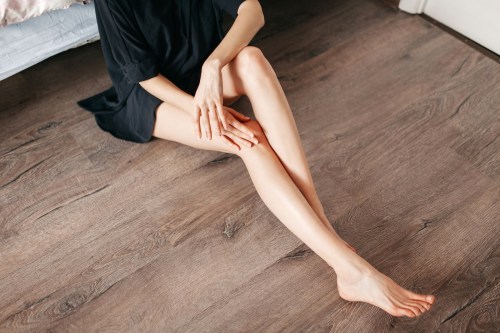The derm-approved plan to ditch “strawberry legs” by summer
I've always wanted to know what those large, darkened pores on my legs are. Here, two dermatologists answer: What are strawberry legs and how to treat them.

There have been times in my life when I look down at my legs (which are rarely bare, FWIW) and notice that the pores look darker than usual. I’ve always chalked it up to just having larger-than-average hair follicles (cool), but never gave it much of a thought besides just thinking: ugh. Then, I came across the term “strawberry legs” and felt extremely seen. Much to my surprise, strawberry legs are not only super common, they’re also something you can easily deal with.
“This happens when the skin of the legs has darker dots in a follicular distribution, so they look like strawberries,” says Purvisha Patel, MD, a board-certified dermatologist and founder of Visha Skincare. “There may also be swelling of the skin and the hair follicles can look slightly indented or raised like the surface of a strawberry.” Board-certified dermatologist Tobechi Ebede, MD, adds that “the darker dots represent hair follicles or enlarged pores that contain a mixture of oil, bacteria, and dead skin or hair trapped in them.”
Know that it’s completely normal. “As mammals, we’re covered in hair follicles and pores, and this appearance can stem from any process that increases inflammation of the hair follicle,” says Dr. Patel. “It could be from not exfoliating, so the pores get blocked with oil and debris, shaving with a dull razor, or not moisturizing skin can create irritation.”
This Parisian Skincare Brand Is Launching in the United States for the First Time—Here’s What a Derm Wants You to Know

We’re Calling It: Cleansing Balms Are the Face Wash of the Future—Here Are 3 to Add to Your Cart

This Is the One Product That Scarlett Johansson Always Keeps in Her Purse and on Her Bedside Table

The different conditions get categorized a bit differently. “If it’s hair follicles mixed with bacteria, this condition is known as folliculitis. If it’s retained keratin—a key component in skin—blocking the follicle, this condition is keratosis pilaris,” says Dr. Ebede. Commonly KP is found on the upper arms, cheeks, and thighs, and the “strawberry” effect will differ in color depending on different skin tones.
If you, like me, are a fan of strawberries, but not having your legs resemble them, I feel you. The most important way to treat them (and prevent them) is through exfoliation.”Exfoliate, exfoliate, exfoliate, then moisturize, moisturize, moisturize,” says Dr. Patel. “This does not mean scrub your leg skin off, but using lotions and cleansers with alpha hydroxy acids can help loosen the top layer of the skin and smooth the pores and decrease the debris.” Then, slather on a soothing moisturizer to repair the top layer of the skin and protect the barrier to prevent inflammation, she says.
Another thing that helps is paying attention to how you’re shaving. “If the strawberry legs are due to folliculitis, your razors should never be kept in the shower due to bacteria build-up that can happen—if possible, using a new razor each time will help,” says Dr. Ebede, who also recommends salicylic acid- or glycolic acid-based lotions.
If it’s more of a keratosis pilaris scenario, though, she says you can use a loofah to slough things off. “Exfoliating with a good loofah is an important step. Then, using an exfoliating lotion will help to smooth things out,” she says.
While strawberry legs might seem like more of a warm weather situation—just like the fruit—that’s not necessarily the case. Both derms just say that these are the times when you notice your legs more (which is true—I don’t see my bare legs from October through May). “It is probably more prevalent in warmer seasons as that is when we shed our clothes and groom our legs more,” says Dr. Patel. “Though we also may look at our bodies more when there are less clothes on them, and we have spent more time shaving them.” Truth. Bring on summer.
Oh hi! You look like someone who loves free workouts, discounts for cult-fave wellness brands, and exclusive Well+Good content. Sign up for Well+, our online community of wellness insiders, and unlock your rewards instantly.
Sign Up for Our Daily Newsletter
Get all the latest in wellness, trends, food, fitness, beauty, and more delivered right to your inbox.
Got it, you've been added to our email list.







